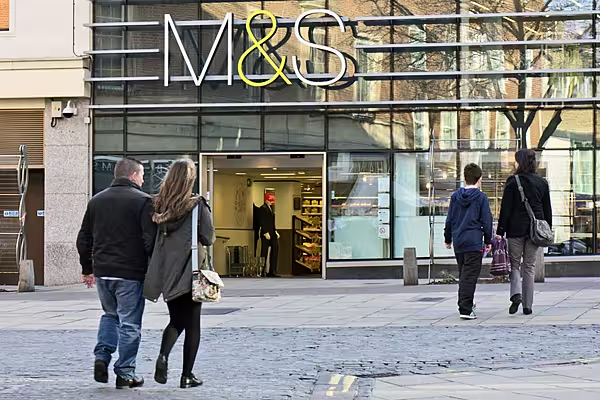When Marks & Spencer Group Plc unveiled its autumn/winter fashion collection last week, for once there was no single superstar item created to "save" the British high street stalwart.
Instead, the retail chain hopes that a range of garments from asymmetric hem skirts to tweed jackets will slot effortlessly into customer wardrobes, boosting its clothing sales.
While there was no must-have showstopper, like the big pink coats and olive green leather dresses of the past, the outlook for M&S seems to be rosier than for some time. But as anyone who follows the company knows, there's a big difference between green shoots and a sustained rise in clothing sales -- particularly womenswear. That's the key to driving up profit.
Anyone looking for reasons to be cautious might find support on Wednesday, when the company reports its yearly financial results. After same-store clothing sales rose in the third quarter, including the crucial Christmas and New Year trading periods, they're expected to have turned negative again in the three months to March 31.
In fairness, the comparison with the previous year's fourth quarter is unflattering for reasons outside M&S's control, with Easter and five days of M&S's post-Christmas sale happening during the final three months of its 2015/2016 financial year. Trading since the end of March may also have been better, thanks to some sporadic bouts of warm weather.
Annual earnings will be down, though, with the company's analyst consensus anticipating 593 million pounds of underlying pretax profit in the year to March 31, compared to 684.1 million pounds in 2015/16.
Improvements
Still, you can see why the equity market is giving the company a little credit. The fashion is improving and prices have fallen in an effort to please "Mrs M&S", the core customer who sustains this most middle class of English stores. M&S has also slashed the number of days on which it runs sales. Revenue might suffer, but the move should be good for the gross margin. That's necessary, given the pressure on margins from the extra cost of sourcing overseas after sterling's slump.
With the appointment of Archie Norman, M&S will have both a chairman and chief executive (Steve Rowe) with retail backgrounds, which hasn't been the case for years. Norman, an outsider, might be a bolder cost-cutter. Rowe's made some inroads, but more pruning is needed.
The shares are certainly pricing in better times. They're up 12 percent this year, while rival Next has fallen 10 percent. That means M&S stock trades at almost 14 times expected earnings, compared to about 11 times at Next.
That premium may be a touch excessive, though, given the number of false dawns at M&S.
While the store closure program is necessary, it will be expensive and there's a danger it won't go far enough with more shutdowns needed. Next, by contrast, has a strong record of actively managing its estate, including a flexible approach to closures and re-locations. Both companies are at risk from a more cautious consumer, but Next's store base shouldn't need such costly wholesale restructuring.
As I've argued before, there's also a danger that the new M&S management team -- including soon-to-arrive Halfords CEO Jill McDonald -- creates tension rather than unity. That's happened in the past. One more reason for M&S to show us that things really are different this time.
This column does not necessarily reflect the opinion of Bloomberg LP and its owners.
News by Bloomberg, edited by ESM. Click subscribe to sign up to ESM: The European Supermarket Magazine.














